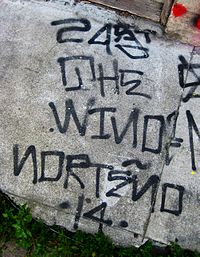- Norteños
-
Norteños 
Territory Northern California, Central California Ethnicity Primarily Mexican/Chicano Criminal activities Extortion, Drug trafficking,[1] assault,[1] auto theft,[1] burglary,[1] homicide,[1] robbery[1] Allies Nuestra Familia Rivals Sureños The Norteños (Spanish: Northerners), also Norte, are affiliated with Nuestra Familia (Our Family), are a coalition of traditionally Latino gangs in Northern California[2] A member of these gangs is a Norteño (male) or Norteña (female) based on Spanish usage. Northern Californians who are not gang members, but feel a strong cultural affiliation with others in Northern California, may also refer to themselves as Norteños/Norteñas or simply "Northerners." The traditional rivals of the Norteños are the Sureños ("Southerners").[3] The statewide dividing line between Norteños and Sureños has roughly been accepted as the rural community of Delano, California.[3] Norteños may refer to Northern California as Norte, Spanish for "north". There are some in other states such as Colorado and Montana.
Contents
History
In 1968,[4] Mexican-American inmates of the California state prison system separated into two rival groups, Norteños (northerners)[2] and Sureños (southerners), according to the locations of their hometowns (the north-south dividing line is near Delano, California).
Norteños affiliated with Nuestra Familia were prison enemies of the Southern Latinos who comprised La Eme, better known as the Mexican Mafia. While the Mexican Mafia had initially been created to protect Mexicans in prison, there was a perceived level of abuse by members of La Eme towards the imprisoned Latinos from rural farming areas of Northern California.[5] The spark that led to the ongoing war between Norteños and members of the Mexican Mafia involved a situation in which a member of La Eme allegedly stole a pair of shoes from a Northerner. This event put into motion the longest-running gang war in the state of California.[5]
Operation Black Widow
Federal law enforcement agencies, long unable to infiltrate the group, began to step up their investigations in the late 1990s.In 2000 and 2001, 22 members were indicted on Racketeer Influenced and Corrupt Organizations Act (RICO) charges including several who were allegedly serving as high-ranking gang leaders while confined in Pelican Bay.[2] Thirteen of the defendants pleaded guilty; the other cases are still ongoing. Two of the defendants face the death penalty for ordering murders related to the Drug trafficking. The largest of the federal investigations was Operation Black Widow.[2]
Renewed organization
In the aftermath of Operation Black Widow, the five highest ranking leaders of the Norteños were transferred to a federal supermaximum prison in Florence, Colorado.[6] The written constitution of the Norteños stated that the leadership of the gang reside in Pelican Bay State Prison in California; the relocation of the gang's leaders led to the confusion of its soldiers and a power struggle of prospective generals.[6]
Three new generals came to power at Pelican Bay, yet two were demoted, leaving only David "DC" Cervantes as the highest ranking member of the gang in California.[6] Cervantes' rise marked the first time in decades that the Norteños had a single leader at the helm of their criminal organization.[6] The remaining leadership of the organization in Pelican Bay consists of Daniel "Stork" Perez, Anthony "Chuco" Guillen and George "Puppet" Franco. While all Norteño soldiers and captains in California are expected to follow the orders of Cervantes, a small percentage of the gang remains loyal to the former generals and captains imprisoned in Colorado.[6] California Governor Arnold Schwarzenegger has complained that keeping the five remaining gang leaders located in the same prison continues to add to California gang violence, and that they should be scattered throughout different prisons. While the recognized leaders of the Norteños in Pelican Bay ask that members respect the former leaders, they have been effectively stripped of their authority.[6] The former leaders include James "Tibbs" Morado, Joseph "Pinky" Hernandez, Gerald "Cuete" Rubalcaba, Cornelio Tristan, and Tex Marin Hernandez.
Symbols and culture
Norteño emblems and clothing are based on the color red.[7] A typical Norteño outfit might include a red belt, red shoes, and red shoelaces.[7] They will also favor sports team apparel that shows their affiliation through symbolism such as the Nebraska Cornhuskers football, UNLV, K-Swiss, and San Francisco 49ers.
Norteños may refer to each other by using the term "Ene", Spanish for the letter "N".[7] Norteños use the number 14 in tattoos and graffiti because "N" is the fourteenth letter of the alphabet.[7] It is sometimes written as "X4", or in Roman numerals as "XIV". Some Norteños will tattoo themselves with four dots.[8] Norteño derogatorily refers to a Sureño as a "Scrap" or "Sur (Sewer) Rat", while a Sureño will likewise refer to a Norteño as a "Buster" or "Chap" (Chapete).
Norteños also lay claim to images of the Mexican-American labor movement, such as the sombrero, machete, and "Huelga bird", symbols of the United Farm Workers.[8]
See also
References
- ^ a b c d e f "Gangs in the United States" (PDF). Narcotics Digest Weekly: 1–12. October 4, 2005. http://www.cicad.oas.org/Crimen_Organizado/ESP/Actualidad/Pandillas%20en%20USA.pdf.
- ^ a b c d Geniella, Mike (2001-04-21). "Federal indictments crack vast prison crime ring". The Press Democrat. Archived from the original on 2007-11-11. http://web.archive.org/web/20071111083726/http://www.pressdemocrat.com/pelican/0421_main.html.
- ^ a b Reiterman, Tim (2008-02-24). "Small towns, big gang issues". Los Angeles Times. Archived from the original on 2008-02-23. http://www.safeneighborhoodsact.com/CrimeStories/tabid/69/articleType/ArticleView/articleId/44/Small-towns-big-gang-issues.aspx.
- ^ Kinnear, Karen L. (2008). Gangs: A Reference Handbook (Contemporary World Issues). Santa Barbara, Calif: ABC-CLIO. pp. 192. ISBN 1-59884-125-4.
- ^ a b Hennessey, Virginia (2003-11-23). "An End to the Cycle". The Monterey County Herald. http://nuestrafamiliaourfamily.org/pages/MCHhennessey.html. Retrieved 2009-06-13.
- ^ a b c d e f Reynolds, Julia (2008-02-24). "New leadership, constitution for Nuestra Familia". The Monterey County Herald. http://www.nuestrafamiliaourfamily.org/pages/MCHnewNF.html. Retrieved 2009-06-13.
- ^ a b c d Bulwa, Demian (2005-05-27). "Sureño gang's threat growing in Bay Area". San Francisco Chronicle. http://www.sfgate.com/cgi-bin/article.cgi?f=/c/a/2005/05/27/BAGQQCVO6G1.DTL. Retrieved 2009-06-13.
- ^ a b Herendeen, Susan (2007-09-20). "Gangs thriving in Modesto". The Modesto Bee. http://www.modbee.com/local/story/72474.html. Retrieved 2009-06-13.
External links
Categories:- Modern street gangs
- Gangs in California
- Prison gangs
- Latino street gangs
- Organized crime groups in the United States
Wikimedia Foundation. 2010.
